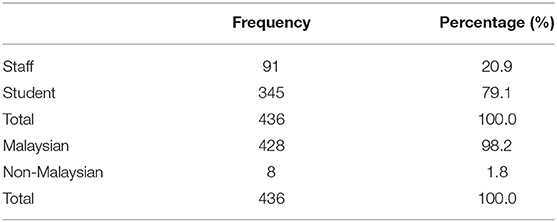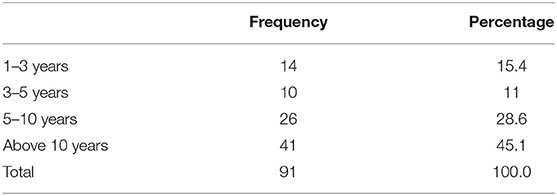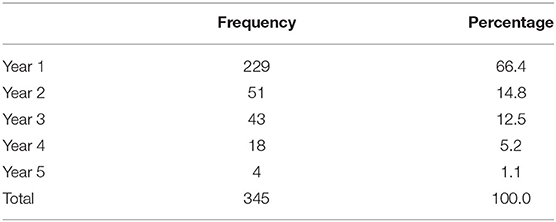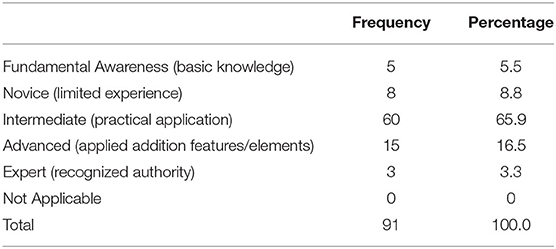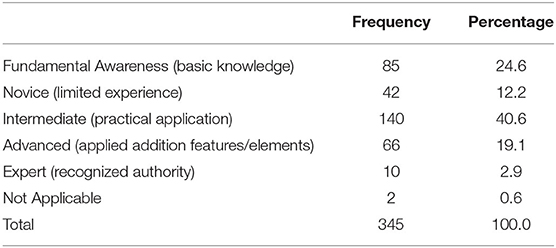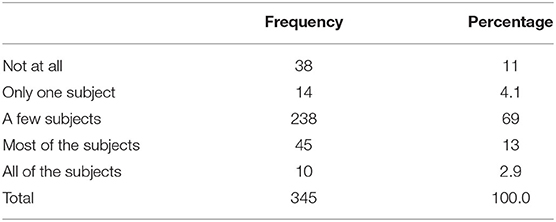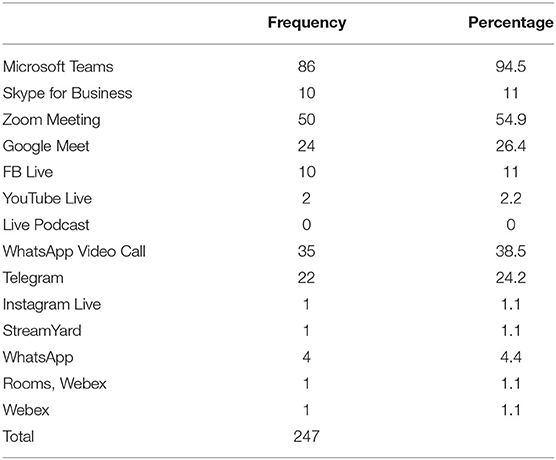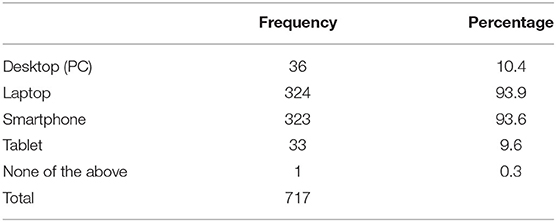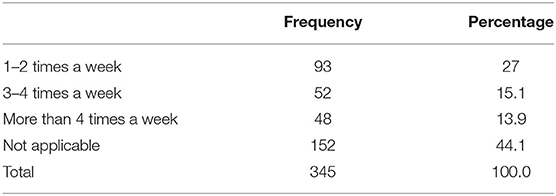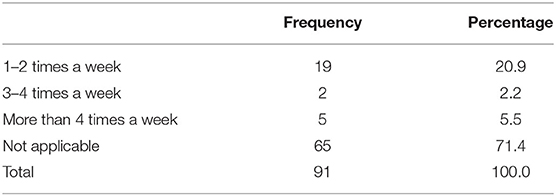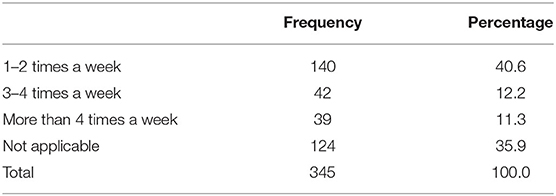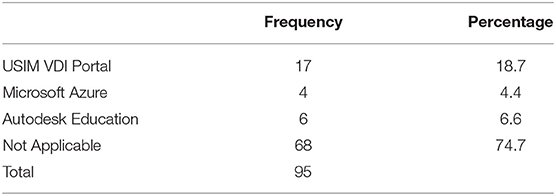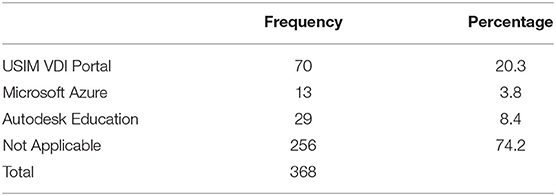Online Learning and Teaching Technology Services: USIM's Experience During COVID-19 Pandemic
- 1Faculty of Major Language Studies, Universiti Sains Islam Malaysia, Nilai, Malaysia
- 2System Development and Engineering Centre, Universiti Sains Islam Malaysia, Nilai, Malaysia
- 3Tamhidi Centre, Universiti Sains Islam Malaysia, Nilai, Malaysia
Introduction
COVID-19, a public health crisis of worldwide importance, was announced by the World Health Organization (WHO) in January 2020 as a new coronavirus disease outbreak and was reported as a pandemic in March 2020. Malaysia reported the first priest's death in Sarawak due to the virus on March 17. The increase in the number of cases to more than 500 cases by mid-March forced the government to make more rigid regulations.
The Coronavirus 2019 (COVID-19) pandemic has caused extraordinary challenges in the global education sector (Crawford et al., 2020). Most countries temporarily closed educational institutions in an attempt to contain the spread of the virus and reduce infections (Tria, 2020). Face-to-face education has ended by numerous schools, universities, and colleges. Educational agencies are trying to find alternative ways to manage this difficult circumstance (Dhawan, 2020).
In Malaysia, the move to online teaching and learning methods accelerated as a consequence of the physical closure of universities and university colleges on 1 April 2020. This shutdown stimulated the growth of online educational activities so that there would be no interruption to education. Many faculties have been involved in how best to offer online course material, involve students, and perform evaluations (Mukhtar et al., 2020). This crisis has forced everyone to adapt to the new technology used in all fields including education. Most educators had to change their approaches to most aspects of their work overnight: teaching, assessment, supervision, research, service, and engagement (Langford and Damşa, 2020; Sangster et al., 2020).
However, among the challenges faced by educators were because of infrastructure problems such as internet connectivity, students experienced distraction and reduced focus in learning online during the COVID-19 pandemic (Maqableh and Alia, 2021). These complications demonstrate students' level of readiness for online learning and have effects on online learning perception and course satisfaction (Wei and Chou, 2020).
Therefore, e-Learning allows students the opportunity to control the subject and arrangement of learning content, learning time rate, and media selection, which is allowing them to fulfill their needs to achieve personal learning objectives (Ruiz et al., 2006). In this study, the researcher focused on identifying the use of e-Learning and technology services among students and academicians of Universiti Sains Islam Malaysia (USIM).
Literature Review
e-Learning
e-Learning is a fast-growing flexible education form and a new style in delivering education in general. e-Learning has been described as a dynamic, innovative, and varied method in providing opportunities to acquire knowledge (Belcher and Vonderhaar, 2005). e-Learning is also referred to as web-based learning, online learning, directed learning, computer-assisted teaching, or Internet-based learning. Students can access classes through the website, LMS and participate in lectures or group discussions according to their schedule. According to Kaplan-Leiserson (2000), e-Learning is teaching and learning processes that use electronic networks (LAN, WAN, or Internet) to convey content, information and even interact through it. Meanwhile, the internet, intranets, satellites, audio-video tapes, interactive tv fans CD-ROMs are part of electronic media that is used to practice e-Learning. The revolution in the learning and application of computer education as well as the use of computers in education is still new and evolving day by day, and finally, the concept of technically guided e-Learning was introduced to supply educational knowledge to students in an effective way (Al-Mobaideen et al., 2012). According to Bertea (2009), some academics consider that e-Learning means any teaching process that integrates any form of technology, but some academics claim that e-Learning represents a teaching solution for distance education, facilitated by the maximum use of the internet as a form of communication. The acceptance of e-Learning is not only changing the traditional mode of learning, the cost of the program, and the online version, but the user can increase the level of teaching effectiveness, save costs and increase the level of student satisfaction in seeking knowledge.
e-Learning in Institutions of Higher Learning (IHLs)
In Malaysia, a study on the implementation of e-Learning in Institutions of Higher Learning (IHLs) was conducted in 2011 by Embi et al. Their study was to observe the status, trends, effectiveness, and challenges of e-Learning integration in teaching and learning in IHLs of Malaysia. The respondents in this research involved administrators, lecturers, and students who are using the e-Learning method. The results show that in general, 42.3% or 11 IHLs offer more than 50% of their courses online (Embi et al., 2011). Their results also show that the most popular e-Learning mode among the IHLs is the supplementary to face-to-face mode, followed by the blended learning model. For students, there are some challenges they face in e-Learning, such as the lack of access, lengthy response time from lecturers, lack of content, time-consuming, and uninteresting content compared to other applications such as Facebook (Embi et al., 2011). In iKlik website, states that e-Learning education is considered worthwhile and flexible, which is notes and tutorials are available from the Internet as well as online lectures. Indirectly, it can save cost and time especially for those who work full-time or live far from the university (Hazwani et al., 2017). The emergence of the development of educational technology that began with the use of personal computers in the early 1980s has influenced the teaching and learning process at all educational institutes. Over time, e-Learning is categorized as a model of lifelong learning, and even its presence is well-accepted among the global community. Society began to understand the importance of knowledge and information thus accepting the concept of e-Learning as a temporary learning model for the future (Asia e University, 2010).
e-Learning Is a Necessity During Pandemic COVID-19
The major part of the world, including Malaysia, has been quarantined due to this serious outbreak of the COVID-19 global pandemic and therefore many cities have turned into phantom cities and the effects can be seen in schools, colleges, and universities as well. The Corona Virus has made institutions go from offline mode to online mode of pedagogy. This crisis will make the institutions, which were earlier reluctant to change, accept modern technology. Institutions and organizations should prepare contingency plans to deal with challenges such as pandemics and natural disasters (Seville et al., 2012). Many universities around the world have fully digitized their operations in understanding the desperate needs of the current situation. Now, online learning is emerging as a very important platform in education around the world, including Malaysia.
Innovative solutions by institutions can only help us deal with this pandemic (Liguori and Winkler, 2020). Therefore, the quality enhancement of online teaching-learning is important at this stage. During these difficult times, the concern is not about whether online teaching-learning methods can provide quality education, but how academic institutions will be able to adopt online learning on a large scale (Carey, 2020). The findings of the current paper corroborate the findings of previous research on the same issues about online learning during COVID-19, and the results showed that students are not happy with distance education and many obstacles have been encountered (Bataineh et al., 2020; Rajab et al., 2020). According to research by Mahyoob (2020) about the general satisfaction of learners with online English language education during the COVID-19 crisis, the discussion found that in the beginning, most have lacked the experience and confidence to learn online using new mediums. After a while, most students could overcome most of the technical issues associated with online learning platforms. According to Weiser (2002), the process of teaching and learning can be more clear and interesting through video streaming methods. Besides, the web-based of teaching and learning methods is one of the mediums that can improve student learning level. Through this method, the learning and teaching process will be more smooth and efficient among students and lecturers. The web-based of learning methods also can help students complete a task given on time efficiently. According to Will Richardson (2010), teaching and learning methods by the online web will make a student being more positive and try to learn information literacy skills by using the internet. Moreover, the usage of this online web not only provides many benefits to the teaching and learning process, but it is also even can create good relationships between students and lecturers.
The Use of Technology Services in Education
Technology is perhaps the strongest factor shaping the educational landscape today (Johnson et al., 2016). The use of technology in education needs to be improved by educators especially in the delivery of information in the current learning system to students at universities. Many universities are showing support for increased levels of technology in the classroom by providing hardware such as computers, enhancing internet connectivity, and implementing programs designed to improve computer literacy for both teachers and students (Johnson et al., 2016). These requirements are important for us to adapt to the progress of this current era i.e. the digital era which is students nowadays tend to think more creatively and innovatively. According to Kern's (Kern, 2006) view technology serves as an intermediary between teachers and students. In addition, media technology is one of the intermediate mediums to convey information among each other. Kop's (Kop, 2011) study explains that one of the biggest contributions of internet technology in education is in terms of the dissemination of learning content without borders.
The use of social media has made the learning process is more interesting and productive. According to a study conducted by Kaplan and Haenlein (2010), social media is defined as a group of internet applications built on ideology and Web 2.0 technologies that allow the production and sharing of user-generated materials. We can see that at first, the use of Facebook as social media are only to get to know and communicate with each other, and now it has turned to educational purposes. According to (Beer, 2008) study, Facebook is the most popular social media among students and society. Through the Facebook site, lecturers and students can access information easily and faster especially information related to current issues, education, and learning.
The internet is very important in the use of e-Learning methods to facilitate educators and students to interact with each other online or deliver information widely. Rader and Wilhelm (2001) say that this method allows students to obtain the information desired in teaching and learning more systematically. In addition, video streaming is also a tool that is often used in the education system and is also known as a creative alternative in creating a teaching and learning environment which is more interesting and effective. According to Littlejohn (2003), the use of video streaming in the teaching and learning process gives a lot of benefits and goodness as it can be encouraging students to be more active, collaborative involvement and interaction between lecturers and students.
Research Objectives
The research was conducted to:
1. Identify the use of online learning among USIM students and academicians.
2. Identify the experience of USIM students and academicians in the use of teaching technology services.
Research Methodology
This quantitative study involved 345 students and 91 staff from Universiti Sains Islam Malaysia who were selected randomly, which is deemed significant to provide useful feedback on both staff's and students' perceptions of online learning. The study used an online survey, which is delivered to participants in the period between September 17 and October 16, 2020. The online survey was created Google Forms and sent to the staff and students through emails, Telegram messages and Whatsapp messages.
The online survey consisting of three sections was used as an instrument to collect data. Section 1 contains demographic information of the students or staff. Section 2 was to identify the use of online learning among students and staff. Section 3 was to identify their experiences in using teaching technology services.
Results and Discussion
Table 1 shows the demographic of the respondents. A total of 436 students and staff from all faculties have participated in the study. 20.9% (91) were staff while 79.1% (345) were students. 98.2% of the respondents were Malaysian while 1.8% were non-Malaysian.
Table 2 shows the total years of teaching experience among staff. The majority of the staff has above 10 years of teaching experience with 45.1%. Besides, 28.6% of 91 staff have 5–10 years of teaching experience. The minority or 11% of the staff has 3–5 years of experience. While the 15.4% staff has only 1–3 years of teaching experience.
Table 3 shows the years of studies among students who were participants in this research. The majority of 66.4% of the students are from year 1 (229). 14.8% from year 2 while 12.5% of the respondents were from year 3 students. This research has also been participated by year 4 and 5 students, which is 5.2% and 1.1%.
Table 4 shows the rate of USIM staff skills in e-Learning. The majority of 65.9% of the staff are intermediate skills in using e-Learning (60). 16.5% have advanced skills. 8.8% of the staff are at the novice level which is they have limited experience in these skills while 5.5% are at fundamental awareness level (basic knowledge). The minority group is at the expert level, which is only 3.3% of respondents. No staff is not applicable in e-Learning skills.
Table 5 shows the rate of USIM student skills in e-Learning. The majority of 40.6% of the students have intermedia (140). 19.1% have advanced skills. 12.2% of the students are at the novice level which is they have limited experience in these skills while 24.6% are at the fundamental awareness level (basic knowledge). The Students who are experts in e-Learning skills are 2.9% of respondents. Lastly, the minority group who are not applicable in e-Learning skills which are only 0.6% of respondents.
Table 6 shows the classification of the understanding of synchronous and asynchronous online learning modes among the staff. The majority of 64.8% of the staff are at an intermediate level about this understanding (59). 16.5% of the respondents are advanced in understanding online learning mode while 9.9% of the staff are in the novice group. Lastly, both fundamental awareness and the expert group have the same results, which is 4.4% of the respondents.
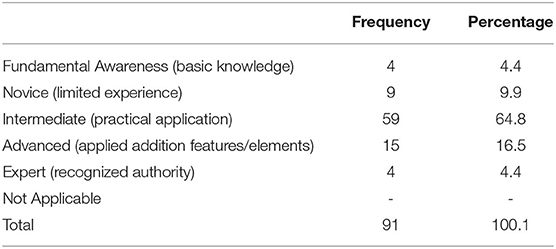
Table 6. The classification of the understanding of synchronous and asynchronous online learning mode among the staff.
Table 7 shows the course that the majority of the respondents i.e. 69% agreed that there are only a few subjects that are very challenging through online implementation. Thirteen percent of the respondents thought that most of the subjects were very challenging for them while only 11% stated that there were no challenging subjects to implement online. 4.1% stated only one subject was challenging for them. Lastly, only a minority group i.e. 2.9% of the respondents thought that all subjects were very challenging for them.
Table 8 shows the communication tools used by staff live conferences in synchronous mode. The majority of respondents use Microsoft Teams for live conferences which are 94.5%. Followed by the Zoom Meeting platform which is 54.9% while via Whatsapp video call is 38.5%. Based on the results, Instagram lives, StreamYard, Rooms, and Webex were the least used platforms by respondents at only 1.1%.
Table 9 shows that laptops are the most frequent personal devices used by students (93.9%) to support teaching and learning. Next, followed by the smartphone which is 93.6%. Desktop usage among respondents was 10.4% while the tablet was 9.6%. Only 0.3% of respondents use devices as mentioned in this questionnaire.
Table 10 shows the frequency of use of learning space among the students. The results show that the majority of respondents do not use the learning space which is 44.1% (152). Then followed by the use of 1–2 times a week by respondents which is 27%. 15.1% use it 3–4 times a week while 13.9% of the respondents use it more than 4 times a week.
Table 11 shows the frequency of use of computer lab among the staff. The results show that the majority of respondents do not use the computer lab which is 71.4% (65). Then followed by the use of 1–2 times a week by respondents which is 20.9%. 2.2% use it 3–4 times a week while 5.5% of the respondents use it more than 4 times a week.
Table 12 shows the frequency of use of computer lab among the students. The results show that the majority of respondents use the computer lab 1–2 times a week which is 40.6% (140). 12.2% of respondents use the computer lab 3–4 times a week while 11.3% of them are using it more than 4 times a week. Finally, 124 respondents which is 35.9% do not the computer lab.
Table 13 shows data related to staff knowledge in accessing software. 18.7% of respondents are using USIM VDI Portal. 6.6% of them were using Autodesk Education while only 4.4% were using Microsoft Azure. The majority of respondents do not use all three software, which is 74.7%.
Table 14 shows data related to staff knowledge in accessing software. 20.3% of respondents are using USIM VDI Portal. 8.4% of them were using Autodesk Education while only 3.8% were using Microsoft Azure. The majority of respondents do not use all three software, which is 74.2%.
Discussion
e-Learning is not considered a new phenomenon as it has long been introduced. However, not all education institutes use this method as the main medium in teaching and learning. This is because the e-Learning method is quite difficult for a few subjects that need face-to-face practical training such as experimenting in the lab. From the results, we can see that majority of the respondents were agreed that there are a few subjects that are very challenging for them to learn through online implementation. However, the current covid-19 pandemic crisis has forced all educational institutions to normalize e-Learning in their teaching and learning process. Bhuasiri et al. (2012) from their study were agreed that there was an increasing global trend of using electronic learning or e-Learning in the last decade and some higher education institutes in developing countries have adopted this trend recently. However, this technology has not been evenly dispersed throughout all nations and cultures (Hodgkinson-Williams et al., 2008). In such a time, the role of teachers is important to provide complete learning materials and increase the use of technology services in learning implementation. The medium or tools chosen should be appropriate and synchronous with the students so that no students are left behind. Therefore, students and educators need to improve their e-Learning skills well so that the learning process be implemented smoothly even online. The results of the study found that the level of mastery of e-Learning skills among the students and staff is at an intermediate level.
Personal devices played a vital role in supporting teaching and learning. Din et al. (2013) suggest that tablet computers allow greater mobility and flexibility in teaching and learning activities. These tablets and smartphones aren't the most powerful gadgets, but they are the most convenient and fresh in education.
Moreover, technology services can improve the teaching and learning process and enhance students' performance as well as course attaintment. Nevertheless, these technology services affected students' behavior to adapt or to leave them (Abdul Ghani et al., 2019). Providing free internet packages to B40 students definitely can solve the internet connectivity issue to ensure achievable learning modalities.
Conclusion
In this study, the majority of students and staff are at an intermediate level in e-Learning skills. This is because, they are still trying to adapt to this new phenomenon, where the COVID-19 pandemic enforced the entire world to rely on technology for education. However, the majority of students have shown their readiness for the implementation of e-Learning where most of them already have personal devices such as laptops and smartphones for the learning process. However, students still need to improve their skills in using technology so that they do not be left behind and be able to adapt to the new educational norms in this pandemic era. This study highlights the USIM's students and staff experience of e-Learning as a tool for teaching and learning within the education field, in developing countries and may lead to strategic development and implementation of e-Learning and view technology as a positive step toward evolution and change.
Data Availability Statement
The original contributions presented in the study are included in the article/Supplementary Material, further inquiries can be directed to the corresponding author.
Author Contributions
MJ, MFA, and MC wrote the first draft of the article. NM, MHA, and NA contributed to the writing and editing of the manuscript. All authors contributed to the editing of the final manuscript.
Conflict of Interest
The authors declare that the research was conducted in the absence of any commercial or financial relationships that could be construed as a potential conflict of interest.
Publisher's Note
All claims expressed in this article are solely those of the authors and do not necessarily represent those of their affiliated organizations, or those of the publisher, the editors and the reviewers. Any product that may be evaluated in this article, or claim that may be made by its manufacturer, is not guaranteed or endorsed by the publisher.
Supplementary Material
The Supplementary Material for this article can be found online at: https://www.frontiersin.org/articles/10.3389/feduc.2022.813679/full#supplementary-material
References
Abdul Ghani, M. T., Wan Daud, W. A. A., and Jaffar, M. N. (2019). Penerimaan pelajar kursus Bahasa Arab di Universiti Malaysia Kelantan terhadap pembelajaran teradun berteraskan Model Penerimaan Teknologi (TAM). Asian People J. 2, 84–94.
Al-Mobaideen, H., Allahawiah, S., and alkhawaldeh, A. (2012). Factors influencing the effectiveness of e-learning systems in the educational process (“electronic learning system”) (EDUWAVE): Jordan case study. Eur. Sci. J. 8. doi: 10.19044/esj.2012.v8n28p%25p
Bataineh, K. B., Atoum, M. S., Alsmadi, L. A., and Shikhali, M. (2020). A silver lining of coronavirus: Jordanian universities turn to distance education. Int. J. Infm. Commun. Technol. Educ. 17, 1–11. doi: 10.4018/IJICTE.20210401.oa1
Beer, D. (2008). Social network (ing) sites. Revisiting the story so far: a response to danah boyd & Nicole Ellison. J. Comput. Mediat. Commun. 13, 516–529. doi: 10.1111/j.1083-6101.2008.00408.x
Belcher, J. V. R., and Vonderhaar, K. J. (2005). Web-delivered research-based nursing staff education for seeking magnet status. J. Nurs. Admin. 35, 382–386. doi: 10.1097/00005110-200509000-00004
Bertea, P. (2009). “Measuring students attitude towards e-learning: a case study,” in Proceedings of the 5th Standing Conference on e-Learning and Software for Development (Bucharist).
Bhuasiri., W, Xaymoungkhoun., O, Zo., H, Rho., J, and Ciganek., A. (2012). Critical success factors for e-learning in developing countries: a comparative analysis between ICT experts and faculty. Comput. Educ. 58, 843–855. doi: 10.1016/j.compedu.2011.10.010
Carey, K. (2020). Is everybody ready for the big migration to online college? Actually, no. The New York Times. Available online at: https://www.nytimes.com (accessed October 10, 2021).
Crawford, J., Butler-Henderson, K., Rudolph, J., Malkawi, B., Glowatz, M., Burton, R., et al. (2020). COVID-19: 20 countries' higher education intra-period digital pedagogy responses. J. Appl. Learn. Teach. 3, 1–20. doi: 10.37074/jalt.2020.3.1.7
Dhawan, S. (2020). Online learning: a panacea in the time of COVID-19 crisis. J. Educ. Technol. Syst. 49, 5–22. doi: 10.1177/0047239520934018
Din, R., Mashakbh, A. F., Kamarulzaman, M. H., Husnin, H., Hamdan, A., and Kamsin, I. F. (2013). E-learning practice in Malaysia: the I-Met model In UKM. Aust. J. Basic Appl. Sci. 7, 224–229.
Embi, A., Wahab, Z. A., Halim, A., Atan, H., Ismail, M., Hussin, S., et al. (2011). e-Learning in Malaysian Higher Education Institutions: Status, Trends, & Challenges. Putrajaya: Department of Higher Education Ministry of Higher Education.
Hazwani, M. N., Noor Raudhiah, A. B., and Norziah, O. (2017). E-Learning Among Students of Higher Education Institutions in Selangor. Attarbawiy: Malaysian Online Journal of Education.
Hodgkinson-Williams, C., Slay, H., and Sieborger, I. (2008). Developing communities of practice within and outside higher education institutions. Br. J. Educ. Technol. 39, 433–442. doi: 10.1111/j.1467-8535.2008.00841.x
Johnson, A. M., Jacovina, M. E., Russell, D. E., and Soto, C. M. (2016). “Challenges and solutions when using technologies in the classroom,” in Adaptive Educational Technologies for Literacy Instruction, eds S. A. Crossley and D. S. McNamara (New York, NY: Taylor & Francis), 13–29.
Kaplan, A. M., and Haenlein, M. (2010). Users of the world, unite! The challenges and opportunities of social media. Bus. Horizons. 53, 59–68. doi: 10.1016/j.bushor.2009.09.003
Kaplan-Leiserson, E. (2000). E-learning Glossary. Available online at: http://www.learningcircuits.org/glossary.html (accessed June 17, 2004).
Kern, R. (2006). Perspectives on Technology in Learning and Teaching Languages (TESOL). California, CA: University of California. doi: 10.2307/40264516
Kop, R. (2011). The challenges to connectivist learning on open online networks: learning experiences during a massive open online course. Int. Rev. Res. Open Distance Learn. 12, 19–38. doi: 10.19173/irrodl.v12i3.882
Langford, M., and Damşa, C. (2020). Online Teaching in the Time of COVID-19: Academic Teachers' Experience in Norway. Oslo: Centre for Experiential Legal Learning (CELL), University of Oslo.
Liguori, E. W., and Winkler, C. (2020). From offline to online: challenges and opportunities for entrepreneurship education following the COVID-19 pandemic. Entrepreneurship Educ. Pedagogy 3, 346–351. doi: 10.1177/2515127420916738
Littlejohn, A. (2003). e-Learning Series No 3 A Guide for Teachers. Learning and Teaching Support Network (LTSN), The Network Centre. Available online at: https://www.dur.ac.uk/resources/its/lt/elearning/ELN063.pdf (accessed July 18, 2021).
Mahyoob, M. (2020). Challenges of e-Learning during the covid pandemic experienced by EFL learners. Arab World Eng. J. 11, 352–362. doi: 10.24093/awej/vol11no4.23
Maqableh, M., and Alia, M. (2021). Evaluation online learning of undergraduate students under lockdown amidst covid-19 pandemic: the online learning experience and students' satisfaction. Child. Youth Serv. Rev. 128, 106160. doi: 10.1016/j.childyouth.2021.106160
Mukhtar., K, Javed, K., Arooj., M, and Sethi, A. (2020). Advantages, limitations and recommendations for online learning during COVID-19 pandemic era. Pak. J. Med. Sci. 36, 27–31. doi: 10.12669/pjms.36.COVID19-S4.2785
Rader, M. H., and Wilhelm, W. J. (2001). Needed Research in Business Education. Little Rock, AR: Delta Pi Epsilon National Professional Graduate Honor Society in Business Education.
Rajab, M., Gazal, A., and Alkattan, K. (2020). Challenges to online medical education during the COVID-19 pandemic. Cureus. 12, e8966. doi: 10.7759/cureus.8966
Ruiz, J. G., Mintzer, M. J., and Leipzig, R. M. (2006). The impact of E-learning in medical education. Acad. Med. 81, 207–212. doi: 10.1097/00001888-200603000-00002
Sangster, A., Stoner, G., and Flood, B. (2020). Insights into accounting education in a COVID-19 world. Account. Educ. 29, 431–562. doi: 10.1080/09639284.2020.1808487
Seville, E., Hawker, C., and Lyttle, J. (2012). Resilience Tested: A Year and a Half of Ten Thousand AFTERSHOCKS. Christchurch: University of Canterbury.
Tria, J. Z. (2020). The COVID-19 pandemic through the lens of education in the philippines: the new normal. Int. J. Pedagog. Dev. Lifelong Learn. 1, 1–4. doi: 10.30935/ijpdll/8311
Wei, H. C., and Chou, C. (2020). Online learning performance and satisfaction: do perceptions and readiness matter?. Distance Educ. 41, 1–22. doi: 10.1080/01587919.2020.1724768
Keywords: online learning, e-Learning, technology services, quantitative, synchronous, asynchronous
Citation: Jaffar MN, Mahmud NH, Amran MF, Abdul Rahman MH, Abd Aziz NH and Che Noh MA (2022) Online Learning and Teaching Technology Services: USIM's Experience During COVID-19 Pandemic. Front. Educ. 7:813679. doi: 10.3389/feduc.2022.813679
Received: 12 November 2021; Accepted: 21 March 2022;
Published: 25 April 2022.
Edited by:
Helmi Norman, National University of Malaysia, MalaysiaReviewed by:
Laura Sara Agrati, University of Bergamo, ItalyIrwan Mahazir Ismail, Universiti Sains Malaysia (USM), Malaysia
Syamsul Nor Azlan Mohamad, MARA University of Technology, Malaysia
Copyright © 2022 Jaffar, Mahmud, Amran, Abdul Rahman, Abd Aziz and Che Noh. This is an open-access article distributed under the terms of the Creative Commons Attribution License (CC BY). The use, distribution or reproduction in other forums is permitted, provided the original author(s) and the copyright owner(s) are credited and that the original publication in this journal is cited, in accordance with accepted academic practice. No use, distribution or reproduction is permitted which does not comply with these terms.
*Correspondence: Mohammad Najib Jaffar, najib@usim.edu.my
 Mohammad Najib Jaffar
Mohammad Najib Jaffar Nurul Husna Mahmud
Nurul Husna Mahmud Mohd Firdaus Amran
Mohd Firdaus Amran Mohamad Hazwan Abdul Rahman
Mohamad Hazwan Abdul Rahman Nur Hafizah Abd Aziz
Nur Hafizah Abd Aziz Mohd Aderi Che Noh
Mohd Aderi Che Noh